Martha O’Brien reviews Many Voices, One Nation 2, Ffotogallery’s latest interactive online exhibition which features the work of twelve photographers working in Wales throughout the pandemic.
After eight months of closure during the COVID-19 pandemic, Ffotogallery reopened its doors on 4th December with their exhibition, Many Voices, One Nation 2. The reopening was bittersweet, as new government restrictions announced that week meant that the gallery was forced to re-close just two days later – and, in spite of plans to open in January, further restrictions make this unlikely. For now, the exhibition is available as an online tour on Ffotogallery’s website.
The question of what Welsh identity is, who it is created by and for, has long been at the centre of arts, culture and politics in Wales. Striving for a consistent image that the nation can call its own, however, might be more limiting than it is patriotic – listening to the voice that shouts the loudest, rather than the many, disparate voices that speak at once.
Many Voices, One Nation began as a touring exhibition, a collaboration between Ffotogallery and the Senedd to mark 20 years of devolution in Wales. Over Lockdown, Ffotogallery invited photography professionals in Wales to nominate photographers, students and artists whose work offers insight into contemporary life in Wales and represents the breadth of Welsh talent that deserves wider exposure. The result is Many Voices, One Nation 2.
The projects featured in the exhibition are distinct in style and wide in scope: from portraiture that documents the personal and the communal to artistic curations that narrate Wales’ natural and political relationship with its landscape and resources. The result is a vibrant depiction of the nation that not only acknowledges but celebrates its personal, cultural and geographical differences.
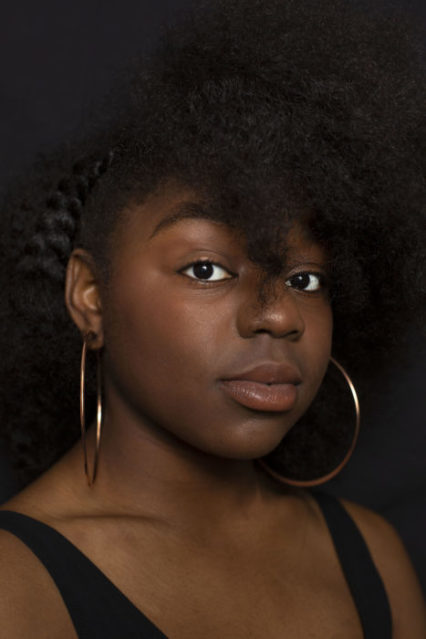
Individual identity and shared culture is at the centre of the exhibition. Antonia Osuji’s Crossing Borders, a National Lottery Heritage Fund project, invites us to reflect on shared heritage and diversity in Wales. Osuji invited her subjects to share their culture through music and dance before taking their photograph. Her portraits offer us a positive depiction of multiracial Wales, with happy and confident subjects; Matthew Eynon’s The Faithful reflects in a similar way on shared culture and inheritance in Wales. Whilst Osuji’s portraits are taken against a black background, each subject given the same context regardless of their personal background, Eynon’s subjects are caught apparently off-guard, going about their daily life and worship. Eynon’s project is a response to the decline in organised religion in Wales – there has been a 14% drop in Welsh people identifying as Christian in Wales since 2011 – alongside the increase in numbers of people who are Buddhist, Muslim, Sikh and Druid. The project challenges traditional conceptions of Wales as a Christian, Baptist country and demonstrates the vibrancy of diversity and change in Wales.
Mohamed Hassan’s Witnessing Wales – Everyday People has a similar message: bringing together individuals from an array of backgrounds who have found belonging in West Wales, Hassan’s intimate photos force us to reflect on identity and nationhood: what is Welshness, and who gets to belong to Wales? This question is asked, too, in Jack Osbourne’s Us, a project documenting active and contemporary youth culture. In identifying the aspects of life that we share, we begin to see how disparate individuals can come together to form communities and how visual cues like fashion can communicate politics and form bonds.
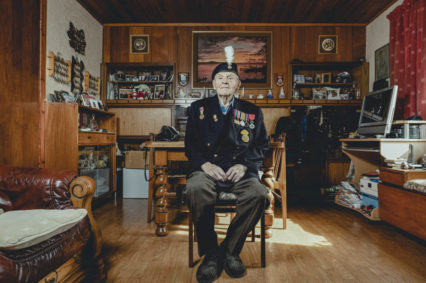
The fashion that communicates a community in Osbourne’s project is rather differently portrayed in John Manley’s Have You Forgotten Yet?, a series of portraits of individuals who have been in past conflicts. The project brings together the historical and the individual, showing men of a range of ages – some men decorated, others in their everyday clothes. It is these clothes that prompt the question of forgetting: how do we know what those around us have been through, if it isn’t visible to us? A television next to the photographs plays photoslides of past battles alongside newspaper headlines. These are images that do not come to mind when we interact with veterans in everyday life: though these men share experiences that create a community, their history, experience, and indeed, their traumas, are hidden to us.
Lucy Purrington’s Your Story, Your Words takes this idea of hidden struggle a step further. Purrington takes words gifted by strangers in conversations about mental health and pairs photographs she has taken with them to create a rousing picture of how mental health looks and feels. The anonymised element of this project takes the individual experience and morphs it into a general one; the particular becomes the universal, the singular, the chorus.
The focus on community – whether forged by locality or shared experience – demonstrates the ways in which belonging to a nation is often defined by belonging to a group. In a year of isolation, however, it’s become clear that belonging is about so much more: that even alone, our identity remains what we believe and want it to be. Kaz Alexander’s My World Through Glass transforms our preconceived notions of isolation as limiting, and depicts its beauty, and capability of producing art. Alexander is severely ill, disabled and housebound; her ‘days and nights are spent in the same disabled raiser/recliner, 24/7, 365’. In spite of this, Alexander still sees the sky through her window: its constant changing colours, moving clouds and shifting depth. The sky, photographed at different hours of the day, communicates the power of deep thought, reflection: even at our most isolated, there is always a way for us to connect with the world outside.
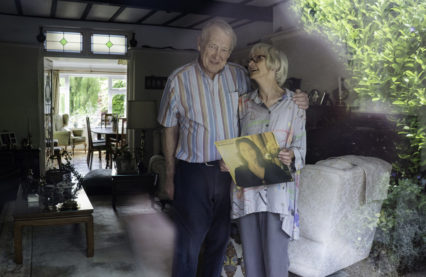
Alexander’s project isn’t the only through-the-window series of this exhibition. Jo Haycock’s Through My Childhood Window came to life during the first UK lockdown in spring. While unable to visit her parents due to lockdown restrictions, Haycock began photographing them through the window of their house. Her parents’ house was, too, her childhood home, holding there strong memories of her past. The glimmer and shine of the window in front of her parents gives the images of them an air of nostalgia – a blurry memory, a faded story. In front of this exhibition, an armchair and table evoke the feeling that we really are in Haycock’s front room – we’re both in front of the glass and behind it, we both observe and belong.
As much as these projects demonstrate our ability to create and sustain our own communities based on shared ideals and experiences, Many Voices, One Nation 2 depicts also the very nation that these many voices occupy, and how living in and being from this land influences and develops Welsh identity.
Ethan Beswick’s The Fruit Bar Line, for example, depicts the North Welsh landscape, demonstrating a ‘repulsion and affection to the place’, and confronting notions of ‘belonging, inadequacy, and desire’. The bleak, misty, grey images offer us a bleak view of Wales: in Beswick’s photographs, a graveyard does not look dissimilar to a mountain of slate.
Abby Poulson’s The Gathering Ground centres around water in Wales. Poulson’s project is a response to the rise of independence and looks at water supplies in Wales – both natural sources of water, – transient reflection and hard rock – and artificial water sources like Tryweryn, a reservoir that was created by drowning the village of Capel Celyn in 1966. Poulson connects this destruction of Welsh land to the growing awareness of national identity and consciousness.
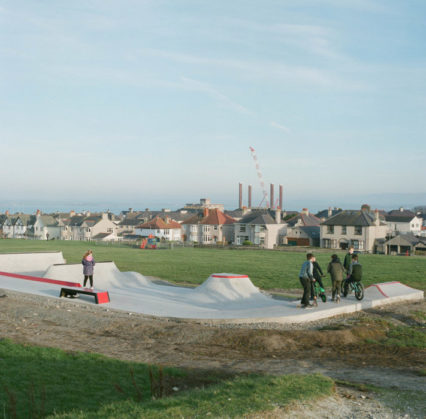
Similarly environmentally focused is Robert Law’s Holyhead – Sea Change?. Law’s project looks at the ‘independently-minded town’ of Holyhead in North Wales, which, like many coastal towns in the UK, voted to leave the European Union, in spite of its status as a seaport and many EU-funded projects in the area. Law suggests that we can gain understanding through seeing Holyhead openly and honestly, rather than writing off the town’s vote as paradoxical or misinformed. The vibrant block colours in these photos reflect a more optimistic, scenic view of Holyhead, rather than one of bleak infighting, and can go some way toward helping us to understand the decisions of these towns and communities.
Most of the projects in this exhibition focus on Welsh people or places in Wales, making Cynthia MaiWa Sitei’s If This is a Human: A Great Curiosity a stand out project. Sitei carried out the research for this project in South Korea, studying the history and formal classification of albinism, and the ways that albino people have been treated in science and culture over time. Sitei’s ongoing project highlights ‘the lack of representation, justice and social inclusion of people with albinism in Wales and England’, and her images were taken in Wales, England, Kenya and South Korea. In linking colonial connections to Wales, Sitei acknowledges colonial connections to Wales which all too often are swept under the rug as English issues.
Many Voices, One Nation 2 demonstrates that it is not important to find one authentic Welsh voice, but instead to celebrate disparity and diversity – and that many voices can indeed speak for one nation.
To enjoy the Ffotogallery’s Many Voices, One Nation 2 as an interactive virtual tour, visit their website here.


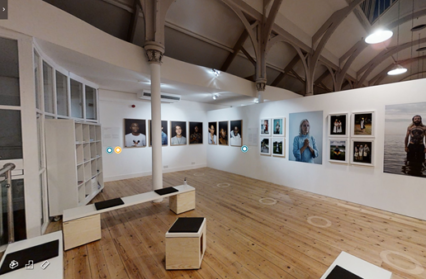
 Enjoyed this article? Support our writers directly by buying them a coffee and clicking this link.
Enjoyed this article? Support our writers directly by buying them a coffee and clicking this link.








